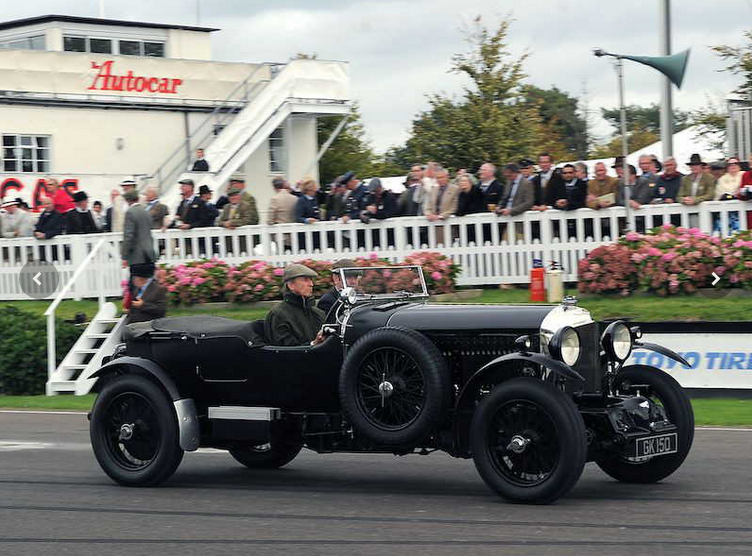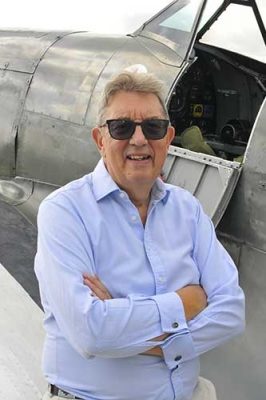Billy Fiske, James Bond, and the Blower Bentley, By Paul Beaver, Board Member, Billy Fiske Foundation

Billy Fiske was a well-connected young man. When he came to Britain to study, he fitted like a glove into the circle of upper middle class, public school educated daredevils who had pioneered winter sports in Switzerland and motor racing at Brooklands circuit. Even as an undergraduate at Cambridge, Billy spent his time questing for speed and excitement. It was mainly big-engined cars which attracted him.
A study into his connections in 1930s’ London reveals a young man, he was barely 20 years old when 21 was the age of adulthood and financial independence, with a passion for living life to the full. At 19 years old, he acquired a very special racing motor car, the Blower Bentley, one of the great, classic automobiles of the 20th century. He is reported to have driven from St James’s in Central London to a Suffolk airfield, Mildenhall in less than 60 minutes; no mean feat on the roads of the 1930s. It would have meant driving at an average 75 mph – Billy could have done it.
This was indeed the age of speed.
At Calshot on Britain’s south coast, in the summer of 1929, Flying Officer Richard Waghorn of the Royal Air Force High Speed Flight registered a world record of 328.63 mph in a Supermarine S6 racing seaplane.
A few weeks later, Malcolm Campbell took his twin-engined, 1000hp Sunbeam racing car to 218 mph at Pendine Sands in Wales, creating a new world record for land vehicles.
At the same moment, a design team in York was working on the Mallard steam locomotive which would reach 125 mph, another world record.

Based in Cambridge and London, Billy was in the midst of the speed phenomenon. He led the 1928 US five-man bobsleigh team to victory at the Winter Olympics. It is thought that Billy steered the sled at over 100 mph, perhaps reaching 125 mph at Games’ venue of St Moritz in Switzerland.
In this quest for speed, the easiest route without the need for snow – something in short supply in England – were large racing cars with mighty engines. The Bentley 4.5 litre roadster was just the machine and Billy was able to acquire one of just 50 which had been specially modified for speed. Registered as GK150, it was painted in Bentley Racing Green, had a long bonnet with Le Mans 24-hour race modifications, including a 42 Imperial galloon fuel tank and improved brakes. GK150 was delivered to Billy’s home in Paris by H M Bentley & Partners in 1930.
The acquisition of the Blower Bentley was enabled by Billy’s relationship with Sir Henry Birkin, better known as ‘Tim’. His friendship brought him not just the nod to buy the car but also the comradery of a select group of privileged young men known as ‘The Bentley Boys’. Tim Birkin was their leader and other names which influenced Billy’s life included The Hon Max Aitken (the son of Lord Beaverbrook who owned the Daily Express newspaper), Charles Amherst-Villers (a contemporary at Cambridge who designed the ‘blower’ or supercharger for the Bentley) and Earl Howe (from the illustrious seafaring and politically well-connected aristocratic family).
Billy was in his element. It was natural then that he would join Whites’ Club on St James’s and mix with other socialites, most of whom were mad on speed – cars, aeroplanes, motorbikes, speedboats.
Bentley Boy Aitken was another Whites’ member and a graduate of Pembroke College, who also loved the thrill of speed and excelled at yacht racing and later, offshore powerboat racing. He would become Billy’s future squadron Officer Commanding on No 601 Squadron in the Battle of Britain and go on to achieve air power greatness with his leadership of the Banff Strike Wing from Scotland and taking the fighting over Norwegian waters in 1944.
The Amherst-Villiers connection is interesting because it brings us to ‘Bond, James Bond’. Charles A-V was an undergraduate at Gonville & Caius College which is how he met Billy. In fiction, the world’s great spy, Bond could well have attended Caius’ and would have met Amherst-Villiers, which is why he drives a supercharged 4.5 litre Bentley in Ian Fleming’s first novel, Casino Royale. Bond’s Bentley was not just the same model as Billy’s, but it was the same colour. After Billy had sold it in 1933, it was modified and painted battleship grey. When the Bentley, registered GK150 came on the market a decade ago, it had been fully restored by a naval commander, repainted in the right shade of battleship grey and could still turn 100 mph plus around the road racing course at Goodwood, just five miles from RAF Tangmere and four miles from Boxgrove Priory, where Billy is buried.
After the war, Amherst-Villiers went to live in New York and painted his great friend, Ian Fleming. Fleming, was, of course, the author of the James Bond novels and on the fringes of The Bentley Boys. He was also a passionate winter sports man who had been to finishing school near Kitzbühel in Austria and loved to ski.
The London of the 1930s was about connections and it was a small world in the stratum of society in which Billy moved. One thing is for certain, Billy’s love of speed propelled him into the Auxiliary Air Force and hence to No 601 Squadron. Sadly, it was there that he died, defending England from Nazi tyranny in August 1940. Like so many Americans who pretended to be Canadian to enlist in the Royal Air Force, the British – and it is not too much of a stretch to say the Free World – owes a very great debt to William Meade Lindsley Fiske III (4 June 1911 – 17 August 1940) and his valiant colleagues from America.

Billy Fiske Foundation Board Member Paul Beaver
Paul Beaver is very much a hands-on historian with a pilot’s log book which includes the Spitfire, Harvard and Mustang. He regularly flies the family Cessna and coordinates the flying at the Chalke Valley History Festival as an authorised civilian and military flying display director. He is an acknowledged expert on the Spitfire, the Battle of Britain, the Dambuster raid, Naval Aviation and Cold War operations. He is a Vice President of the Spitfire Society.
To commemorate the 75th anniversary of the Battle of Britain, Paul launched a series of heritage posters and a Flypast Guidebook which led to him being the historical advisor to Channel 4’s presentation of the Battle of Britain at Goodwood. His latest book, SPITFIRE EVOLUTION was published on 5th March, 2016 to coincide with the 80th anniversary of the maiden flight of the Type 300 which became the Spitfire. His latest book is FORGOTTEN FEW, the story of the naval pilots in the Battle of Britain.
Paul spent 15 years directly linked to Jane’s including Naval Editor and Publisher & Editor in Chief of Jane’s Defence Weekly. He made JDW into a household name in 1990 through his broadcasting during the Liberation of Kuwait and eventually became a freelance war correspondent for Sky News and a studio ‘expert’ for BBC News and CNN International, for whom he jointly presented the 50th Anniversary of D-Day (from Normandy), VE-Day (from Moscow) and the Hong Kong Handover. He is also a Trustee of the Barnes Wallis Foundation and the Army Flying Museum, a former Trustee of the International Bomber Command Centre, as well as member of the Air & Space Power Association, a member of the Royal Air Force Historical Society and the Battle of Britain Historical Society. In June 2014, he delivered a sell-out lecture at the Chalke Valley History Festival, taking the people, places and politics of the Spitfire as his theme, which led to Spitfire People, published in June 2015 with a foreword by the late Captain Eric (Winkle) Brown CBE DSC AFC RN. Paul is writing Winkle’s biography for publication by Penguin Random House in September, 2020.
Paul is a Member of No 601 Squadron, Royal Auxiliary Air Force which traces its history back to before the Battle of Britain. Previously, he had been an army aviation reservist, retiring in 2013 with the rank of Colonel. From 2014-16, he was Chairman of No 1010 (City of Salisbury) Squadron of the Air Cadet Organisation and retains a strong interest in education, has advised the Aviation Skills Partnership on armed forces related STEM. He lectures regularly at the Army Flying Museum and for the Royal Aeronautical Society of which he is a fellow. He is a member of the Guild of Battlefield Guides.




